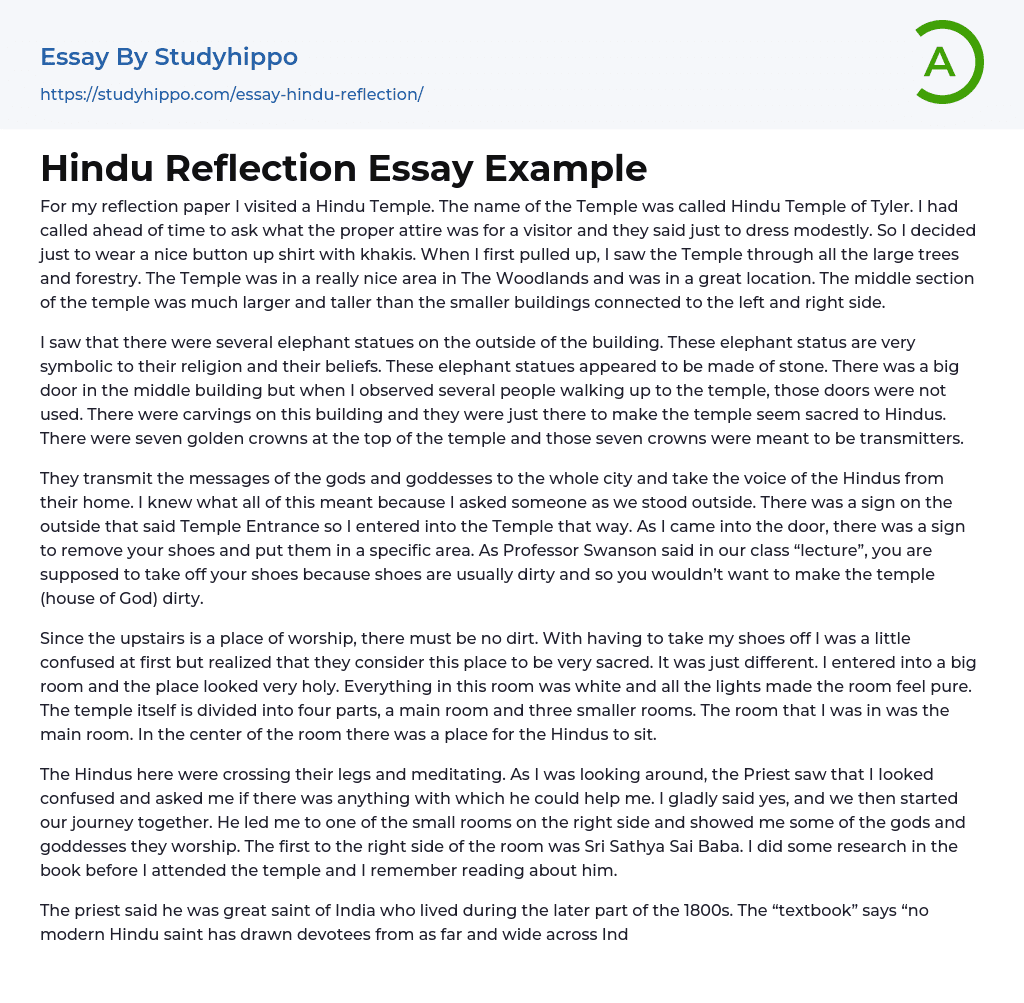During my reflection paper, I had the chance to go to the Hindu Temple of Tyler. Before my visit, I reached out to them to ask about what clothes would be appropriate and they recommended dressing modestly. So, I decided to wear a button-up shirt with khakis. When I got there, I immediately noticed that the Temple was surrounded by beautiful greenery and trees. Its location in The Woodlands was truly stunning. What really caught my attention was the main part of the temple, which was tall and impressive compared to its smaller neighboring structures.
The temple featured numerous elephant statues, which hold significant religious symbolism. These stone elephants were prominently showcased, and despite a central entrance door, visitors appeared to access the temple from an alternate route. The carvings on the building contrib
...uted to the sacred ambiance for Hindus. Atop the temple, seven golden crowns acted as transmitters.
The temple functions as a link between the deities and the whole city, enabling Hindus to express their beliefs. I acquired knowledge about these customs from an individual whom I conversed with outdoors. An external indication marked it as the Temple's entrance, hence I entered through that route. Upon entering, a notice instructed visitors to take off their shoes and deposit them in a designated area. As Professor Swanson mentioned during our "lecture", it is traditional to remove one's shoes due to potential dirtiness, ensuring purity within the temple (the abode of God).
The upstairs area is a sacred place of worship that must be kept clean. Initially, I was uncertain about the reason for removing my shoes, but I quickly
understood the importance attributed to this site. It was a remarkable encounter. I entered a roomy space that emitted an aura of holiness. The entire room was decorated in white, and the ample lighting generated an ambiance of purity. The temple consists of four sections: a main room and three smaller rooms. The room where I found myself was the central area, where Hindus could sit.
During my observation of Hindus meditating with crossed legs, a Priest noticed my confusion and kindly offered assistance. Grateful for his help, we embarked on our journey together as he led me to a small room on the right. In that room, he introduced me to the gods and goddesses worshipped by the Hindu community. Upon entering from the right side of the room, I immediately recognized Sri Sathya Sai Baba as someone I had previously researched in relation to the temple.
According to the "textbook", during the late 1800s, a priest in India claimed to be a renowned saint. The textbook portrayed Sathya Sai Baba as a Hindu saint who attracted followers from India's urban middle classes and had deep knowledge of his religion. It also emphasized his support for an active lifestyle centered around studying scriptures and performing charitable deeds. After examining the side rooms, the priest came back to the main room to talk about Sri Venkateswara Vishnu, who is acknowledged as the Supreme Being.
Sri Venkateswara, the sustainer, protector, and preserver of the universe, guided me through his domain before performing a ritual. In this ritual, he presented a plate with a lit candle and rang a bell while chanting alongside the
other gods. Afterward, he offered the plate to fellow Hindus so they could transfer the warmth from the candle to their own bodies, by touching it to their faces. He explained that the candle's light symbolizes energy. The priest then placed a hat over the heads of the Hindus.
According to him, the touch of god's feet purifies Hindus' minds. He then distributed holy water and fruit to them. Even if they don't bring an offering, the priests still give them something to take home, highlighting the significance of not leaving empty-handed. While talking, I pondered the meaning behind the red dot on his forehead. He explained that it acts as a protection against misfortune.
During my visit, I noticed the white stripes on his forehead and inquired about their meaning. He informed me that they were made of holy ash and symbolize the eventual transformation of the body into ash after death through cremation. This showed their deep understanding of their religious beliefs. The style of worship I witnessed was unlike anything I had seen before. In my usual church experience, a leader stands at the front and guides the congregation, who are typically limited to standing or sitting. However, in this Hindu congregation, everyone actively participates in the service.
- Mahayana essays
- Afterlife essays
- Atheism essays
- Bible essays
- Buddhism essays
- Christian Worldview essays
- Christianity essays
- Confession essays
- Cosmological Argument essays
- Deism essays
- Devil essays
- Existence of God essays
- Faith essays
- Freedom Of Religion essays
- God essays
- Hinduism essays
- Immortality essays
- Islam essays
- Jainism essays
- Jews essays
- Judaism essays
- Miracle essays
- Monk essays
- Monotheism essays
- New Testament essays
- Old Testament essays
- Pilgrimage essays
- Puritans essays
- Revelation essays
- Ritual essays
- Salvation essays
- Sin essays
- Sinners essays
- Soul essays
- Taoism essays
- Temple essays
- Theology essays
- Adam And Eve essays
- Baptism essays
- Catholic Church essays
- Christian essays
- Church essays
- Crucifixion Of Jesus essays
- Crusades essays
- Elizabeth essays
- Eucharist essays
- God The Father essays
- Holy Spirit essays
- Jesus Christ essays
- Lord essays




